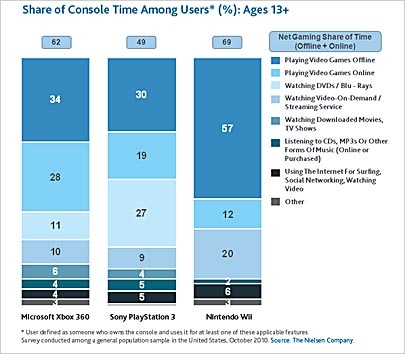Study: Gaming consoles are taking over living room entertainment hubs

It's no surprise that more and more people are streaming TV shows and movies over the Internet rather than relying on the old standard, cable. But, according to a recent Nielsen study, set-top box manufacturers have something to worry about as gaming consoles are slowly but surely becoming the premier entertainment hubs in living rooms.
Set-top boxes from Boxee, Roku and a few other companies offer more niche channels (especially for sports) and have products that can cost up to hundreds of dollars less than a gaming console.
But console manufacturers are catching on - particularly with the addition of Netflix streaming on the Nintendo Wii, Sony PlayStation 3 and Microsoft Xbox 360. It also helps that both the Xbox 360 and PlayStation 3 support DVD playback, with the PS3 also ready for Blu-ray discs.
As Nielsen's study found, gaming is still the number one use for these three apparatuses. But here's a closer look at the findings. DVD/Blu-ray playback surpasses Internet streaming usage time and comes in at second place for most popular feature. Wii owners, however, use video-on-demand services 20% of the time, while it occupies 10% of Xbox 360 owners’ time and 9% of PlayStation 3 owners’ time.
While this is a good start, if gaming manufacturers are serious about making their consoles into true entertainment hubs, there needs to be much further development in video-on-demand services. More channels, more variety, and more current programming. Hulu Plus on the PlayStation 3 is only the start.
But set-top boxes are obviously still a good option for those who want something cheaper and efficient with a lot of content to offer. And maybe for those who don't like gaming at all.
[Image via MediaPost]
Related coverage on ZDNet:
